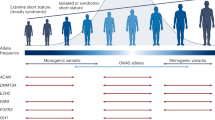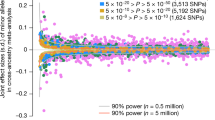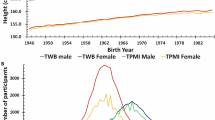Abstract
In the Victorian era, Sir Francis Galton showed that ‘when dealing with the transmission of stature from parents to children, the average height of the two parents, … is all we need care to know about them’ (1886). One hundred and twenty-two years after Galton's work was published, 54 loci showing strong statistical evidence for association to human height were described, providing us with potential genomic means of human height prediction. In a population-based study of 5748 people, we find that a 54-loci genomic profile explained 4–6% of the sex- and age-adjusted height variance, and had limited ability to discriminate tall/short people, as characterized by the area under the receiver-operating characteristic curve (AUC). In a family-based study of 550 people, with both parents having height measurements, we find that the Galtonian mid-parental prediction method explained 40% of the sex- and age-adjusted height variance, and showed high discriminative accuracy. We have also explored how much variance a genomic profile should explain to reach certain AUC values. For highly heritable traits such as height, we conclude that in applications in which parental phenotypic information is available (eg, medicine), the Victorian Galton's method will long stay unsurpassed, in terms of both discriminative accuracy and costs. For less heritable traits, and in situations in which parental information is not available (eg, forensics), genomic methods may provide an alternative, given that the variants determining an essential proportion of the trait's variation can be identified.
Similar content being viewed by others
Log in or create a free account to read this content
Gain free access to this article, as well as selected content from this journal and more on nature.com
or
References
Galton F : Regression towards mediocrity in hereditary stature. Journal of the anthropological institute 1886; 15: 246–263.
Fisher RA : The correlation between relatives on the supposition of Mendelian inheritance. Trans R Soc Edinb 1918; 52: 399–433.
Visscher PM, Medland SE, Ferreira MA et al: Assumption-free estimation of heritability from genome-wide identity-by-descent sharing between full siblings. PLoS Genet 2006; 2: e41.
Lander ES, Linton LM, Birren B et al: Initial sequencing and analysis of the human genome. Nature 2001; 409: 860–921.
Weedon MN, Lango H, Lindgren CM et al: Genome-wide association analysis identifies 20 loci that influence adult height. Nat Genet 2008; 40: 575–583.
Lettre G, Jackson AU, Gieger C et al: Identification of ten loci associated with height highlights new biological pathways in human growth. Nat Genet 2008; 40: 584–591.
Gudbjartsson DF, Walters GB, Thorleifsson G et al: Many sequence variants affecting diversity of adult human height. Nat Genet 2008; 40: 609–615.
Hofman A, Breteler MM, van Duijn CM et al: The Rotterdam Study: objectives and design update. Eur J Epidemiol 2007; 22: 819–829.
Pardo LM, MacKay I, Oostra B, van Duijn CM, Aulchenko YS : The effect of genetic drift in a young genetically isolated population. Ann Hum Genet 2005; 69: 288–295.
Aulchenko YS, Heutink P, Mackay I et al: Linkage disequilibrium in young genetically isolated Dutch population. Eur J Hum Genet 2004; 12: 527–534.
Li Y, Abecasis GR : Rapid haplotype reconstruction and missing genotype inference. Am J Hum Genet 2006; S79: 2290.
Hanley JA, McNeil BJ : The meaning and use of the area under a receiver operating characteristic (ROC) curve. Radiology 1982; 143: 29–36.
Ash A, Shwartz M : R2: a useful measure of model performance when predicting a dichotomous outcome. Stat Med 1999; 18: 375–384.
Janssens AC, Pardo MC, Steyerberg EW, van Duijn CM : Revisiting the clinical validity of multiplex genetic testing in complex diseases. Am J Hum Genet 2004; 74: 585–588; author reply 588–589.
Janssens AC, Aulchenko YS, Elefante S, Borsboom GJ, Steyerberg EW, van Duijn CM : Predictive testing for complex diseases using multiple genes: fact or fiction? Genet Med 2006; 8: 395–400.
Wilson PW, D’Agostino RB, Levy D, Belanger AM, Silbershatz H, Kannel WB : Prediction of coronary heart disease using risk factor categories. Circulation 1998; 97: 1837–1847.
Falconer DS, Mackay TFC : Introduction to Quantitative Genetics, 4 edn, Harlow, Essex, UK: Addison Wesley Longman, 1996.
Aulchenko YS, Ripatti S, Lindqvist I et al: Genome-wide association study in 16 European population cohorts: major loci influencing lipid levels and coronary heart disease risk. Nat Genet 2009; 41: 47–55.
Kayser M, Liu F, Janssens AC et al: Three genome-wide association studies and a linkage analysis identify HERC2 as a human iris color gene. Am J Hum Genet 2008; 82: 411–423.
Acknowledgements
We thank Professor T Frayling for useful discussion and comments and Dr M Bevova for comments and graphical art support. We acknowledge the work of Dr F Rivadeneira, Dr M Moorhouse, P Arp and M Jhamai, who created the Rotterdam Study genotypic database. This research was supported by grants from the Netherlands Foundation for Scientific Research (NWO), a joint grant from NWO and the Russian Foundation for Basic Research (RFBR), by the Centre for Medical Systems Biology (CMSB) and by the Netherlands Forensic Institute (NFI). MNW is a Vandervell Foundation Research Fellow. Genome-wide genotyping of Rotterdam Study is supported by NWO (175.010.2005.011).
Author information
Authors and Affiliations
Corresponding author
Additional information
Supplementary information accompanies the paper on European Journal of Human Genetics website (http://www.nature.com/ejhg)
Supplementary information
Rights and permissions
About this article
Cite this article
Aulchenko, Y., Struchalin, M., Belonogova, N. et al. Predicting human height by Victorian and genomic methods. Eur J Hum Genet 17, 1070–1075 (2009). https://doi.org/10.1038/ejhg.2009.5
Received:
Revised:
Accepted:
Published:
Issue date:
DOI: https://doi.org/10.1038/ejhg.2009.5
Keywords
This article is cited by
-
Lenz microphthalmia syndrome in neurosurgical practice: a case report and review of the literature
Child's Nervous System (2021)
-
A generalized model for combining dependent SNP-level summary statistics and its extensions to statistics of other levels
Scientific Reports (2019)
-
RETRACTED ARTICLE: Predicting adult height from DNA variants in a European-Asian admixed population
International Journal of Legal Medicine (2019)
-
Using information of relatives in genomic prediction to apply effective stratified medicine
Scientific Reports (2017)
-
Using a system of differential equations that models cattle growth to uncover the genetic basis of complex traits
Journal of Applied Genetics (2017)



